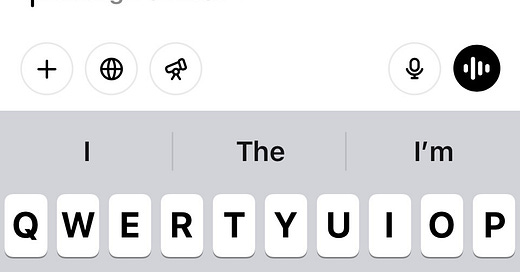This morning, I woke up early and after feeding the pups, I opened ChatGPT app on my phone and to my surprise, I saw that ChatGPT’s widely praised Deep Research Model is now available to ChatGPT Plus and Teams users. The little telescope icon activates Deep Research.
This is a significant development. Before this release, Deep Research was only available to ChatGPT Pro users before today. A Pro subscription is $200 per month, which was out of reach for many users when compared to the $20 per month for Plus or $30 for Teams. As these things sometimes go, I literally subscribed to Pro a couple of days ago for the purpose of testing Deep Research. In my initial tests, Deep Research has been impressive. I'll write more about my tests soon.
As the name implies, Deep Research actually does research before preparing its response. It also thinks through its research before starting it and usually asks clarifying questions before getting to the real work. It's a bit eerie—it almost seems like you're texting with a human research assistant. The results of my early testing are beyond impressive. My first test was a pre-submission review of a journal article a colleague and I are planning to submit to a top journal. With a pretty simple prompt and a few answers to clarifying questions, Deep Research produced a 16 page (single-spaced) developmental review that will help us strengthen the paper before we submit it. This should be a big boost to our chances of having the paper accepted.
My second test is proprietary, so I can't reveal the topic. But, I can say that with minimal effort on my part, Deep Research produced a 34 page report that was well-researched and comprehensive. The report will save me hours, possibly days of work on a major project. Of course, I won't pass off Deep Research's work as my own and I'll double-check the content. Fortunately, double-checking is easy since Deep Research cites its sources.
If you don't have Deep Research yet, be patient. OpenAI often does rolling releases so it may be a while before everyone gets access. Also, use limits are low. Reports indicate that Plus and Teams users will get 10 Deep Research queries per month. So, think about how you want to spend your quota rather than just playing around. By the way, one pro tip is to use one of the reasoning models to help you refine your Deep Research prompt to improve your results.
Although I’ve only done a single test, Deep Research using my Plus account seems to act the same way as Deep Research using my Pro account. The Plus session asked slightly different clarifying questions, but otherwise the process of producing the report was the same. Plus took about 16 minutes to produce the report, which is similar to Pro. The reports were different though. Plus produce a 20 page report, which is considerably shorter than the 34 pages produced by Pro. This might be an anomaly though so I’m not ready to draw conclusions about differences in quality. I’ll do a thorough comparison and report back to you, so be sure to subscribe if you haven’t already.
This is a huge development in the evolution of generative AI. I think that we'll look back on the release of Deep Research to lower tier customers as a major turning point in AI, especially in higher education. Frankly, I'm not sure what this means for the future of scholarship. Although scholarship certainly isn't dying, the way we "do" scholarship is about to change in a major way. A similar statement could be made about any form of academic research. It's 3:30 AM as I'm writing this, so my brain isn't fully functioning yet. I'll provide more thoughts on Deep Research means for higher ed in the coming days. For now, I'll just say that things are going to change. The question of how remains.





